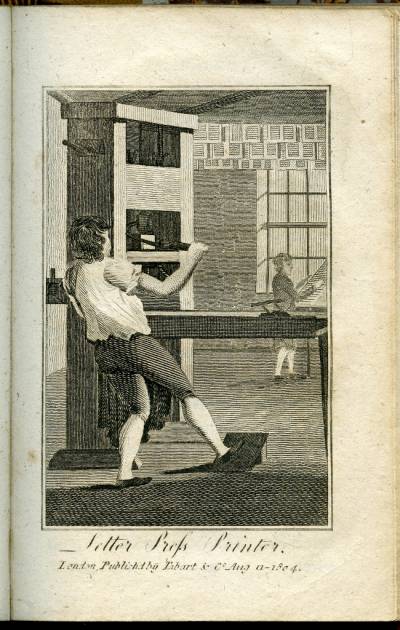There have always been many specialist trades within the printing industry.
In lithography for instance, a printing plate with a relief image is dampened with water and then coated in ink. The ink only sticks to the parts of the plate that are not wet with water. The printing plate is fixed to a roller and the image is transferred onto paper fed under the roller.

Letterpress Printer
Letterpress printing is the oldest form of printing. In this method, a surface with raised letters is inked and pressed to the surface of the printing substrate (typically paper) to reproduce an image in reverse. Typically, metal type has been used but other possibilities include carved wood or stone blocks.
Typography is the art and technique of arranging type to make written language readable and beautiful. The arrangement of type involves selecting typefaces, print size, line length, line spacing, letter spacing and adjusting the space between pairs of letters.
All visually displayed text involves typography – whether it is on paper, a computer screen or a billboard. Typography is performed by typesetters, compositors, typographers, graphic designers, art directors, manga artists, comic book artists, graphic artists, clerical workers etc.

Bookbinder
Bookbinding is the process of physically assembling a book from a number of folded or unfolded sheets of paper or other material. It usually involves attaching a book cover to the resulting text-block. Historically the trade was divided into stationery or vellum binding, which deals with making new books intended to be written into, eg accounting ledgers, and letterpress binding which deals with making new books intended to be read.
Today, modern bookbinding is divided between hand binding by individual craftspeople, and mass-produced bindings by high-speed machines in a bindery factory.
The Library holds material relating to many different unions of the graphical trades, including lithographic unions, printing and bookbinding unions, typographical unions and wallpaper unions.
Click here to download a description of the work of a letter press printer (opens as a pdf)
Click here to download a description of the work of a bookbinder (opens as a pdf)
Resources about the graphical trades in the library collection
Joseph W Zaehnsdorf, The art of bookbinding: a practical treatise, 2nd ed (1890) - Shelfmark: S45
H J Plender, The preservation of leather bookbindings (1967) - Shelfmark: D38
Josh Bailey, The poor printer: being the letters of one master man to another, for the benefit of printers in general (1918) - Shelfmark: A31
Andrew Whitehead (ed.), On the road: journeys of a tramping printer (1982) - Shelfmark: M06
Eileen Cadman, Gail Chester, Agnes Pivot, Rolling our own: women as printers, publishers and distributors (1981) - Shelfmark: I03
W Fox, Printers, press and profits: a study of the newspaper and general printing trades in London and in the provinces - their share bonuses, their profits, their dividends, their directors and their workers (1933) - Shelfmark: AG Labour Research Department
Ellic Howe (ed.), The trade: passages from the literature of the printing craft, 1550-1935 (1943) - Shelfmark: A19
George Woolley, The printing industry: what is its future? (ca. 1961) - Shelfmark: AG Communist Party of Great Britain Box 8
Ramsay Macdonald (ed.), Women in the printing trade: a sociological study (1904) - Shelfmark: B49
Allen Hutt, The changing newspaper: typographic trends in Britain and America, 1622-1972 (1973) - Shelfmark: N26

